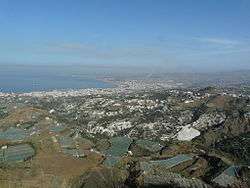Baniyas
| Baniyas بانياس | |
|---|---|
 | |
 Baniyas Location in Syria | |
| Coordinates: 35°10′56″N 35°56′25″E / 35.18222°N 35.94028°E | |
| Country |
|
| Governorate | Tartus Governorate |
| District | Baniyas District |
| Elevation | 25 m (82 ft) |
| Population (2009 est.) | |
| • Total | 43,000 |
| Time zone | EET (UTC+2) |
| • Summer (DST) | +3 (UTC) |
| Area code(s) | 43 |
Baniyas (Arabic: بانياس Bāniyās) is a city in Tartous Governorate, northwestern Syria, located 55 km south of Latakia (ancient Laodicea) and 35 km north of Tartous (ancient Tortosa)
It is famous for its citrus fruit orchards and its export of wood. North of the city is an oil refinery, one of the largest in Syria, and a power station.
On a nearby hill stands the Crusader castle of Margat (Qalaat el-Marqab), a huge Knights Hospitaller fortress built with black basalt stone.
History
In Phoenician times, it was an important seaport. Some have identified it with the Hellenistic city of Leucas (from colonists from the island Lefkada) mentioned by Stephanus Byzantius. It was a colony of Aradus (Strabo, XVI, 753), and was placed by Stephanus Byzantius in the late Roman province of Phoenicia, though it belonged rather to the province of Syria.[1] In Greek and Latin, it is known as Balanaea or Balanea.
Bishopric
The bishopric of Balanea was a suffragan of Apamea, the capital of the Roman province of Syria Secunda, as is attested in a 6th-century Notitiae Episcopatuum.[2] When Justinian established a new civil province, Theodorias, with Laodicea as metropolis, Balanea was incorporated into it, but continued to depend ecclesiastically on Apamea, till it obtained the status of an exempt bishopric directly subject to the Patriarch of Antioch.[1]
Its first known bishop, Euphration, took part in the Council of Nicaea in 325 and was exiled by the Arians in 335 later Timotheus was at both the Robber Council of Ephesus in 449 and the Council of Chalcedon in 451. In 536, Theodorus was one of the signatories of a letter to the emperor Justinian against Severus of Antioch and other non-Chalcedonians. Stephanus participated in the Second Council of Constantinople in 553.[3][4]
In the Crusades period, Balanea became a Latin-Rite see, called Valania in the West. It was situated within the Principality of Antioch and was subject to the Latin-Rite metropolitan see of Apamea, whose archbishop intervened in the nomination of bishops of the suffragan see in 1198 and 1215.[5][6][7] For reasons of security, the bishop lived in Margat Castle.[1]
No longer a residential bishopric, Balanea is today listed by the Catholic Church as a titular see.[8]
During the early 21st-century Syrian civil war, rebel sources reported that a massacre took place on 2 May 2013, perpetrated by government forces.[9]
References
| Wikimedia Commons has media related to Baniyas. |
![]() This article incorporates text from a publication now in the public domain: Vailhé, Siméon (1907). "Balanaea". In Herbermann, Charles. Catholic Encyclopedia. 2. New York: Robert Appleton.
This article incorporates text from a publication now in the public domain: Vailhé, Siméon (1907). "Balanaea". In Herbermann, Charles. Catholic Encyclopedia. 2. New York: Robert Appleton.
- 1 2 3 Siméon Vailhé, "Balanaea" in Catholic Encyclopedia (New York 1907)
- ↑ Echos d'Orient 1907, p. 94.
- ↑ Michel Lequien, Oriens christianus in quatuor Patriarchatus digestus, Paris 1740, Vol. II, coll. 921-924
- ↑ Pius Bonifacius Gams, Series episcoporum Ecclesiae Catholicae, Leipzig 1931, p. 436
- ↑ Konrad Eubel, Hierarchia Catholica Medii Aevi, vol. 8, p. 139
- ↑ Jean Richard, Note sur l'archidiocèse d'Apamée et les conquêtes de Raymond de Saint-Gilles en Syrie du Nord, in Syria. Archéologie, Art et histoire, Year 1946, Volume 25, n° 1, pp. 103–108 (especially p. 107)
- ↑ Du Cange, Les familles d’outre-mer, Paris 1869, p. 814
- ↑ Annuario Pontificio 2013 (Libreria Editrice Vaticana 2013 ISBN 978-88-209-9070-1), p. 845
- ↑ "Syrians flee 'massacres' in Baniyas and al-Bayda," BBC (4 May 2013). Retrieved 6 May 2013.
Coordinates: 35°10′56″N 35°56′25″E / 35.18222°N 35.94028°E

